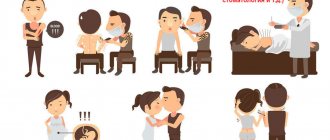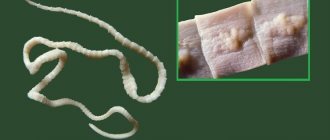Celiac disease - what is this disease?
Celiac disease, or celiac disease, is an immune reaction to eating gluten, a protein found in wheat, barley and rye. This is not a gluten sensitivity or a wheat allergy, as many often think.
In patients with celiac disease, the consumption of gluten triggers an autoimmune process in the body, leading to atrophy of the mucous membrane of the small intestine, impaired absorption of nutrients (malabsorption and lactose intolerance), and in advanced cases, intestinal cancer. Nutrient deficiency can lead to neurological and cognitive impairment, chronic skin inflammation, anemia, infertility, problems with the musculoskeletal system, teeth, coordination of movements, and disability.
There is no cure for celiac disease because it is a genetically determined inability of the body to break down gluten in the small intestine. Exclusion of this product from the diet and a strict lifelong “gluten-free” (gluten-free) diet lead to complete recovery.
Precautionary measures
It is important for a child with celiac disease to abstain from gluten-containing foods throughout his life. For allergy sufferers - only for the period when the body reacts negatively to protein, that is, for them a gluten-free diet will be temporary. Some people need to follow it for several weeks or months, while others will have to endure up to 1-3 years. In all cases, it is necessary to carefully monitor your diet, excluding foods such as:
- Cereals in the form of pastries, cakes, pastries, cookies, buns and bread
- Semolina, wheat, oatmeal, as well as multigrain ready-made porridges (they usually contain gluten-containing cereals)
- Canned food
- Semi-finished products, sausages, sausages, industrial pates - almost all of them contain gluten as a thickener.
- Sauces, including ketchup and mayonnaise
- Yoghurt and other fermented milk products are allowed only after careful monitoring of composition and tolerance.
Breastfed babies face celiac disease or gluten allergy when introducing complementary foods, because mother's milk contains not only gluten, which comes with the foods of the nursing diet, but also protective factors - antibodies.
If a child receives formula, it is important to make sure that there are no allergies to cow's milk protein and to choose the right basic nutrition. Unfortunately, in most cases, both with an allergy to gluten and with celiac disease, it is necessary to completely eliminate cow's milk protein and replace the standard milk formula with a specialized one (hydrolyzed, soy formula). Adapted standard formulas and, especially, specialized formulas for children with food allergies (protein hydrolysates, amino acid and soy mixtures) do not contain gluten. But complementary foods, vegetable, fruit and meat purees may contain traces of gluten. It is worth carefully studying the annotations and labels of medicines. Gluten may be included in some medicines.
When introducing cereal complementary foods to children with gluten intolerance, you need to choose gluten-free porridge (rice, buckwheat, corn); from 8-9 months you can introduce millet porridge. Millet is also a gluten-free grain, but it is quite difficult to digest, so it is better to introduce it into the diet later, when the baby is already accustomed to grain-based complementary foods. If mom prefers to cook herself, the cereals must be thoroughly washed, since they are often contaminated with traces of gluten during storage and transportation. Even for a healthy baby, you should not start introducing cereal complementary foods with gluten-containing cereals; you need to make a choice in favor of gluten-free cereals. But it makes no sense to delay the introduction of gluten-containing cereal complementary foods for a long time. It is best for all healthy children to introduce gluten-containing cereals into the diet between 4 and 6 months, after the child has already been successfully introduced to gluten-free cereals. Presumably during this period, the so-called “window of tolerance,” there is the least likelihood of developing an allergy to gluten.
Symptoms of celiac disease
The signs and symptoms of celiac disease differ between children and adults.
Symptoms of celiac disease in adults
The clinical picture in adults is as follows:
- pain and bloating, increased gas formation,
- diarrhea or constipation,
- nausea and vomiting,
- chronic fatigue,
- weight loss.
Adult patients with undiagnosed celiac disease can be treated throughout their lives for dyspepsia, flatulence, and stool disorders. More than half of adult patients with celiac disease experience not only gastroenterological symptoms, but a whole range of problems:
- general weakness, pale skin, mouth ulcers (due to impaired iron absorption);
- joint pain, osteoporosis, osteomalacia (due to impaired calcium absorption);
- itchy skin rash (Dühring's dermatitis herpetiformis);
- headache, numbness of the extremities, tingling in the feet and hands, cognitive impairment, leg cramps (neurological disorders);
- balance and coordination disorders (gluten ataxia);
- decreased spleen function (hyposplenism);
Symptoms of celiac disease in children
Children with celiac disease are more likely than adults to have digestive problems, including the following clinical symptoms:
- nausea and vomiting,
- chronic diarrhea or constipation,
- colic, gas, bloating,
- light-colored stool with a pungent odor.
An acquired inability to absorb nutrients from food can lead to:
- developmental delay (short stature, delayed puberty, etc.);
- rickets, dental growth disorders, caries;
- underweight;
- neurological symptoms, including attention deficit hyperactivity disorder (ADHD), learning disabilities, irritability or depression, headaches, poor coordination, and cramps in the calves and feet.
Consult a gastroenterologist if gastrointestinal problems have been bothering you for more than two weeks. Consult your pediatrician if your child is pale, irritable, stunted, or has problems with bowel movements.
An appointment with a gastroenterologist at the TRADITIONS SPB medical center is carried out daily during the center’s business hours by calling +7 (812) 323‑07‑49
and
+7 (921) 932‑14‑79
, as well as via WhatsApp, Viber, live chat and forms on the website. We are located within walking distance from Vasileostrovskaya metro station. We make house calls to all areas of St. Petersburg and the Leningrad region.
Prevention
There is no primary prevention for celiac disease. Secondary prevention comes down to diet and annual examination by a gastroenterologist. Pregnancy management in those suffering from this disease should be carried out with increased attention, since this pathology increases the risk of developing heart defects in the fetus.
Due to the variety of symptoms, diagnosis of celiac disease can only be carried out by qualified specialists using the latest techniques. The medical specialist has everything necessary to conduct a comprehensive examination of the patient’s body. You can make an appointment with a gastroenterologist at any time by phone or through the form on the website.
Sources:
- Bai J. WGO-OMGE / J. Bai, E. Zeballos, M. Fried // Practice Guideline Celiac Disease. - 2005. - Vol. 10. - P. 1-8.
- Belmer S.V. Celiac disease: from pathogenesis to treatment / S.V. Bellmer, T.V. Gasilina // Issues of modern pediatrics. - 2013. - T. 12. - No. 3. - P. 12-17.
- Kamalova A.A. Evolution of approaches to the diagnosis and treatment of celiac disease / A.A. Kamalova, M.O. Pirogova // Bulletin of modern clinical medicine. - 2013. - T.6. — Vol. 3. - pp. 40-48.
- Mikhalik D.S. Celiac disease: disease and lifestyle / D.S. Mikhalik [and others] // Zemsky doctor. - 2012. - No. 4. - P. 35-38.
- Roslavtseva E.A. Celiac disease: unresolved problems of pathogenesis, diagnosis and treatment / E.A. Roslavtseva [and others] // Issues of modern pediatrics. - 2005. - T. 4. - No. 6. - P. 48-57.
Causes of celiac disease
Celiac disease is inherited (90% of patients with celiac disease are carriers of the HLA-DQ2 gene, another 10% - the HLA-DQ8 gene) and is accompanied by some other diseases. You are at risk if one of your blood relatives suffers from:
- celiac disease or dermatitis herpetiformis;
- diabetes mellitus type 1;
- Down syndrome or Turner syndrome;
- autoimmune thyroiditis;
- microscopic colitis (lymphocytic or collagenous colitis);
- Addison's disease.
Even if you have a set of genes that predispose you to celiac disease and you consume foods with gluten, the disease does not necessarily manifest itself immediately. Genes can “wake up” under the influence of the following factors:
- pregnancy, childbirth, breastfeeding,
- bacteria and viruses,
- operations,
- strong emotional shocks.
Signs of celiac disease in children
The symptoms of this disease in children are similar to the symptoms present in adults, but still differ in some features:
- prolonged diarrhea (exceeds one week);
- lack of weight gain with adequate feeding;
- flatulence or gas formation that exceeds the normal norm;
- fatigue, moodiness
If adults caring for a baby notice the described symptoms, then they need to exclude celiac disease from the possible list of pathologies.
Diagnosis of celiac disease
Important!
If you stop eating gluten-containing foods or even reduce the amount of gluten in your diet before testing, this will affect the test results. Take tests only under the supervision of a doctor!
Tests for celiac disease
The diagnosis of developed celiac disease and gluten ataxia is based on immunological tests, which determine the amount of specific antibodies:
- antibodies to tissue transglutaminase,
- antibodies to gliadin,
- antibodies to endomysium and reticulin.
Differential diagnosis
To differentiate from allergies
The doctor may prescribe the determination of specific IgE antibodies to wheat and gluten.
Gluten ataxia
- damage to the nervous system by gluten - can occur as an independent disease and is not necessarily accompanied by celiac disease, i.e. damage to the small intestine. Among patients with celiac disease, gluten ataxia occurs in approximately 4% of cases. In both cases, a gastroenterologist will refer you for a consultation with a neurologist.
In recent years, foreign classifications have begun to identify non-celiac gluten sensitivity
, which is often confused with a gluten allergy. It occurs in the population up to 20 times more often than celiac disease. Gluten hypersensitivity does not progress and does not lead to complications. A hypersensitive person is able to eat thousands of times more gluten (before negative symptoms appear) than a patient with celiac disease. The diagnosis is made based on clinical signs to the exclusion of other pathologies.
Additional tests
As already mentioned, the antibodies produced in patients with celiac disease in response to gluten damage the intestinal villi. The villi should be able to absorb vitamins, minerals and other nutrients from food, but they cannot. As a result, you do not get enough iron, potassium, sodium, calcium, and vitamin D from food, no matter how much you eat. In addition, increasing damage to the rectal epithelium sometimes leads to lactose intolerance and even cancer.
For celiac disease, a gastroenterologist may additionally prescribe the following types of tests:
- general blood analysis;
- total protein test;
- albumin test;
- electrolyte analysis;
- measuring calcium levels;
- iron test;
- alkaline phosphatase test;
- coprogram;
- FGDS (fibrogastroduodenoscopy);
- biopsy of a section of the intestinal mucosa.
Gluten attacks - health suffers
Typically, celiac disease manifests itself during the first two years of a child's life . This often happens at 4-8 months of age, when mothers decide to feed their babies semolina porridge, milk formula, and give them cookies. Gluten intolerance may also appear later if the introduction of gluten-containing products into the diet is delayed for some reason.
universal symptoms of celiac enteropathy , that is, their severity varies. The clinical picture that is observed in children under two years of age can be called classic. It is as follows:
- increased abdominal circumference;
- decreased appetite;
- chronic diarrhea;
- vomit;
- intestinal dysbiosis;
- behavioral disorders (the child is irritable or, conversely, apathetic);
- growth retardation and/or retardation in physical development;
- thinning or complete absence of the subcutaneous fat layer.
Separately, it should be said about stool with celiac disease . In all respects it is atypical: abundant, liquid, distinctly pale or “multi-colored”, pasty consistency, foaming . Parents describe it more colorfully, saying that it is like eggplant caviar, sometimes reminiscent of rising dough or soap suds. The degree of abundance can be judged by the fact that the pot instantly fills to the brim. undigested food remains are found in the stool , which makes it resemble vomit. In some young patients, it has an “unpredictable” consistency, being mushy, liquid, or even formed. But in all cases its excessive abundance is noted.
In some cases, symptoms are less pronounced or completely absent. This is possible if the disease is detected in children over two years of age. These forms of celiac disease are called atypical. The difference from “classic” glutenenteropathy is that non-intestinal symptoms predominate. For example, an incomprehensible growth retardation or anemia that has arisen for no apparent reason. In patients, tooth enamel may be affected.
Treatment of celiac disease with diet
Some patients complain that a special diet does not help them. The lack of positive dynamics in the treatment of celiac disease with diet is often associated with errors in menu planning. This is why it is so important not to self-medicate, but to consult a nutritionist.
With a gluten-free diet, not only cereals, pasta, flour, and baked goods with gluten are excluded, but also products containing the so-called. “hidden gluten” (gluten). Because of gluten's ability to thicken and stick together, gluten is added, for example, to yoghurts, ice cream, oatmeal, some medicines and cosmetics.
If in this case the symptoms do not go away, further examinations will be needed. Associated health problems may prevent remission from occurring:
- Bacteria in the small intestine (bacterial overgrowth);
- Microscopic colitis;
- Pancreatic insufficiency;
- Irritable bowel syndrome;
- Impaired digestion of sugar found in dairy products (lactose), table sugar (sucrose) or sugar found in honey and fruits (fructose).
Refractory celiac disease
In rare cases, intestinal damage really cannot be corrected even with a strict, well-designed gluten-free diet. This condition is known as refractory celiac disease
. If you do not improve within the first 6-12 months after switching to a gluten-free diet, you will need to undergo further testing.
Telephone numbers of the TRADITIONS medical center:
+7 (812) 323‑07‑49 and +7 (921) 932‑14‑79
Opening hours: Mon-Fri 9.00 - 21.00; Sat-Sun 10.00 – 18.00
Endoscopic examination and related manipulations
Fibrogastroduodenoscopy is the main method for diagnosing celiac disease. This test involves inserting a probe into the duodenum through the mouth and esophagus. Penetrating into the duodenum through the stomach, the probe shows the internal state of these organs through a video camera attached to the end. The whole picture goes on the monitor screen.
Fecal analysis - feces are examined to determine the degree of digestibility of food.
In this case, a sample of the mucous membrane is taken, which is subsequently examined under a microscope. For a more detailed examination, it is stained with special reagents. The purpose of microscopy is to analyze the structure and size of the intestinal villi. If a person has celiac disease, they will be smaller in size than normal, and the number of glandular cells will also not correspond to the usual numbers. The villi may be atrophied. Such degenerative changes in the intestinal villi are the most dangerous consequence of gluten intolerance.
Celiac disease. Man does not live by bread alone
Authors : Magazine "Seventh Petal"
Unfortunately, not all diseases are diagnosed at the birth of a child and in the first months of his life. Sometimes parents are sure that they are raising a healthy baby - well, there are problems with bowel movements, and they are not gaining weight well. But these are frequent companions of infancy! However, digestive problems can be caused by an intolerance to gluten, a protein found in wheat, rye and barley. And then the aphorism in the title of the article is filled with a new, not at all metaphorical meaning...
Many babies are gluten intolerant when they start complementary feeding. Therefore, pediatricians recommend giving the baby the so-called up to one year old. gluten-free cereals - rice, buckwheat, corn. Typically, as the child gets older, his digestive and enzymatic systems mature, and the problem goes away on its own. However, in some children this intolerance becomes a disease. With celiac disease—that’s the name of this disease—there should be no wheat, rye, barley or products containing these grains on the table. But the most important thing is that a gluten-free diet is for life.
What is celiac disease? Celiac disease is also known as celiac disease, non-tropical sprue, and gluten sensitive enteropathy. Medical reference books define celiac disease as a chronic disabling disease characterized by damage to the mucous membrane of the small intestine by gluten* (more precisely, its component gliadin) - a plant protein, gluten, which is found in the main types of cereals. Intolerance to this protein causes a chronic immune inflammatory reaction, leading to damage to the villi in the small intestine, resulting in a syndrome of impaired intestinal absorption (malabsorption).
| * Gluten is a mixture of two proteins: gliadin and glutenin. Gluten gives grains an important property - when they are mixed with water, they become sticky, begin to trap air, and can be used to make dough. Gluten is found in wheat, rye, barley, and oats. These grains, as well as all products containing even minor impurities, should be permanently excluded from the diet of a patient with celiac disease. At the same time, according to the latest data, oats themselves do not contain gluten, but the “pure” form of oats is almost never found in Russia, because its contamination (transformation) occurs during processing |
If the disease is not diagnosed on time, with prolonged exposure to gluten on the immune system of a sensitive person, its disorders develop with damage to other organs - autoimmune and oncological diseases. The most insidious feature of this incurable disease is that it can be detected at any age. Often, neither parents nor doctors realize that their child has celiac disease. Let's take a real case as an example. “Since he was six months old, my son has had problems with bowel movements, poor appetite, and his stomach is constantly bloated. I have always had difficulties gaining weight - at six years old I weigh only 14 kg. with a height of 110 cm. At the children's clinic we were diagnosed with rickets. And only six months ago, after going to a gastroenterologist and conducting tests, we were diagnosed with celiac disease.” The first thoughts of all parents whose children have been diagnosed with this disease are usually the same: “What kind of disease is this? How to live with her? Can she be cured? Now this information is not difficult to find - it periodically appears in parenting magazines, as well as on the Internet. After all, this disease, unfortunately, is not so rare - the incidence of celiac disease in Europe is 1:200-1:300 people. This disease is more common than previously thought - according to recent data, up to 1% of the population suffers from some form of celiac disease. Experts say that for every identified case in Europe, there are 7 to 10 undetected ones. In Russia, celiac disease is still considered a rare disease. This point of view is explained by the difficulties of diagnosis. The use of relevant research has recently made it possible to identify both the classical and latent (latent) forms of this disease in many patients.
How can you tell if your child has celiac disease? Symptoms and diagnosis This disease was characterized back in 1888 - at that time Samuel Gee described in detail the clinical features of celiac disease. And in 1921, Howland first recommended excluding complex carbohydrates from the diet of children with celiac disease. Various symptoms may indicate celiac disease. Typical ones include: abdominal pain, diarrhea or persistent constipation, loss of strength, bloating and (or) increase in its circumference, changes in appetite (from its complete absence to a sharp increase), nausea and vomiting, lag in weight and height (primarily in children), bone pain, spontaneous fractures, aggressive behavior, isolation, apathy, depression, itching, allergic lesions of the skin and respiratory system, frequent viral diseases, lethargy, fatigue, anemia, osteoporosis, lack of vitamins and minerals, intolerance lactose, nosebleeds or other bleeding.
| If you suspect celiac disease... Mandatory laboratory tests: One-time • Complete blood count • Reticulocytes • Serum iron, ferritin • General urine test • Coprogram • Bacteriological examination of stool • Histological examination of biopsy • Serum immunoglobulins • Blood cholesterol • Total protein and protein fractions Mandatory instrumental studies: One-time • Ultrasound of the liver, biliary tract and pancreas Double • Esophagogastroduodenoscopy and targeted biopsy of CO from the distal duodenum or jejunum |
The disease affects both sexes and can begin at any age, from infancy (as soon as grains are introduced into the child’s diet) to old age (even among those who eat grain products constantly). For celiac disease to start, three things are needed: eating gluten-containing grains, a genetic predisposition, and what is called a “trigger factor.” The “trigger factor” can be anything - excessive consumption of wheat, severe emotional stress, physical or pathological effects (pregnancy, surgery, viral infection), etc. The role and nature of action of this mechanism have not yet been precisely established, just as the exact algorithm (pathogenesis) of the development of the disease is unknown. Recognizing celiac disease is often difficult because some of its symptoms are similar to those of other diseases, including irritable bowel syndrome, ulcerative colitis, intestinal diverticulosis, intestinal infections, chronic fatigue syndrome, and depression. Special studies have found that people with celiac disease have higher than normal levels of certain antibodies in their blood. These antibodies are produced by the immune system against substances that the body perceives as threatening its condition. Thus, to diagnose celiac disease, you need to check the level of antibodies to gluten in the blood (these are antigliadin, antiendomysial and antireticulin antibodies). If symptoms and laboratory findings make celiac disease highly likely, your doctor may remove a tiny piece of tissue from the small intestine to check whether the intestinal villi are damaged. This is done during a procedure called a biopsy: a long, thin tube (endoscope) is inserted through the mouth and stomach into the small intestine, and then the desired tissue sample is removed using an instrument passed through the endoscope. A small bowel biopsy is the best way to detect celiac disease.
Disabled or healthy child? Do parents of a child with celiac disease have the right to apply for disability? Theoretically, yes, because even the official definition of celiac disease calls it a “disabling disease.” Previously, a child diagnosed with celiac disease received disabled status for up to 5 years. And any parent understands that what is important here is the level of social support that the state provides to a child whose disease can only be treated in one way - an expensive gluten-free diet. However, the criteria for disability have now changed. They are determined not so much by the child’s illness as by the limitation of his life activity. Indeed, if celiac disease is not detected in a timely manner, it can lead to the development of a whole “bouquet” of diseases, which will entail a limitation of the child’s life. In foreign medical literature, celiac disease is called the “great mime”, since its manifestations and complications are varied and depend on the individual characteristics of the body. Thus, with a long course of unrecognized celiac disease due to prolonged intoxication of the body with gluten, severe secondary immune disorders begin: diabetes mellitus, mental retardation, chronic inflammation of the liver, joint diseases, damage to the thyroid gland, stomatitis, intestinal ulcers, tumors of the oral cavity and gastrointestinal tract, chronic temperature conditions, infertility and gynecological diseases, epilepsy and schizophrenia. Celiac disease in many cases causes not only decreased ability to work and disability, but also cancer with a high degree of mortality.
However, by following a strict diet, all these consequences can be avoided. Fortunately, there are no restrictions on life activity - the child grows and develops in the same way as his peers. This means that he is not entitled to disability, despite the need for a lifelong expensive diet. Here’s what the mother of a child with celiac disease says: “But they didn’t give us disability. They said it was a healthy child. Of course, we follow a diet, play sports, study at a specialized school, and are also handsome. It doesn’t matter, apparently, that our lungs are working at 64% capacity, we have a history of asthma... And, you know, I decided that means we are healthy and will break through on our own!”
Another mother, raising a three-year-old daughter with celiac disease, says this: “It is important how you treat celiac disease. Disease? For us - no!!! Lifestyle, and a healthy one? For us - YES!!! My subjective opinion is that our children are not SICK! They are healthy! There are many serious diseases in which children cannot live a full life, run and play with peers, play sports, dance. And our children live like everyone else, they make us happy, all the doors in this world are open for them. And we should be happy."
How to treat? The only treatment for celiac disease is the complete and lifelong exclusion of gluten from entering the patient’s body, including with medications. Throughout his life - if a person is interested in its long and prosperous course - he will have to follow a gluten-free diet. If there is no improvement, doctors prescribe medication depending on the severity of the condition (including anabolic hormones, enzyme preparations, and glucocorticoid therapy). Perhaps the main problem for parents is explaining to a child with celiac disease the need to follow a diet and instilling in him a conscious attitude towards this situation. The only true way to this is to talk “like an adult” (regardless of the child’s age). Practice has shown that children perceive cooing and coaxing as a game. Imagine, for example, this situation - a mother says to her baby: “You can’t eat this. You have special, magical food." And when a child is treated to something tasty in the absence of his parents, he may ask: “Is this magic candy?” And here it is, a trap! Of course, an adult who wants to pamper and please a child will answer “yes.” Therefore, the main task of parents is to try to prevent such situations. There is only one way out: to convince the child that dieting is not a game, but a vital necessity. Understanding the need for a diet - as a way to live and not experience pain - children remember “allowed” and “forbidden” foods and, as a rule, are not mistaken.
Personal experience of parents raising children with celiac disease shows that children, as a rule, have a reasonable and responsible attitude towards diet therapy, perceiving it as the norm and a way of life. Oddly enough, children with celiac disease have much more difficulty explaining to other people - adults and peers - why they have to give up certain foods. Often, others consider the need to follow a diet to be just a whim. And often this becomes a problem that gives rise to a negative attitude towards such patients.
| DIET FOR CHILDREN WITH CELIAC DISEASE Gluten-containing products made from wheat, rye, barley and oats are excluded from the diet of people with celiac disease. Cereal products allowed include corn, rice, and buckwheat. It is necessary to eat a sufficient amount of meat, fish, poultry, dairy products, as well as vegetables and fruits, unless their consumption is limited due to concomitant pathology or individual intolerance. In particular, many patients with celiac disease are not recommended to consume whole milk (but they can take fermented milk products) due to frequent intolerance to the milk sugar lactose. It is recommended to consume special gluten-free products certified for consumption by persons with celiac disease. On the labels of such products there is a symbol - a crossed out ear. Important! Some products may not list cereal ingredients but may still contain them. Thus, products may contain so-called. “overt” gluten, as well as “hidden” gluten. Products containing “obvious” gluten: - porridges made from wheat, rye, barley and oats, including semolina, pearl barley and “hercules” porridges, Artek porridge, dishes with pearl barley; - flour from wheat, rye, barley, oats. Products made from this flour; - bread, crackers, buns, pies made from the above flour. Breaded dishes. Bread crumbs in various products; — pasta (pasta, horns, vermicelli, noodles, etc.); — confectionery products, including pastries and cakes; - cutlets (breaded); - sausages, sausages. Products that may contain “hidden” gluten: - sweets; — instant dry soups, — ice cream; bouillon cubes; — mayonnaise, ketchup, sauces, vinegar; — canned meat and fish; — soy products; - instant coffee, cocoa powder. Gluten also contains: - some cosmetics, including creams; - glue on stamps and envelopes; - some types of toothpaste and lipstick. |
| Gluten-free recipes for every day and for holidays A gluten-free diet does not mean giving up delicious food! The recipes below will allow you to pamper yourself and your children. Pie “CHARLOTTE” Ingredients. 3-4 eggs, 1 glass of sugar, 1 glass of rice flour, 3 apples. Preparation. Beat eggs with sugar, add flour and stir well. Grease a frying pan with oil and sprinkle with corn or rice flour. Add the chopped apples and pour over the whipped mixture. Bake for 30 minutes at a temperature of 180-190 degrees. Turn the baked cake over and sprinkle with powdered sugar. Lazy dumplings Ingredients. 100 g of cottage cheese, 3 potatoes, 1 egg, 2-3 tablespoons of corn flour (starch). Preparation. Boil the potatoes and pass through a meat grinder along with the cottage cheese. Mix with remaining ingredients. Knead a medium-hard dough, form into balls and boil them in salted water. Express Khachapuri Composition. Dough. 1 cup gluten-free flour, 200 g cottage cheese, 125 g margarine, 1/2 tsp. quenched soda, 1 egg. Filling. 150 g grated cheese, 1 egg, 1 tablespoon sour cream. Preparation. Knead the dough and form two flat cakes. Grease the mold and place the cake in the mold. Place the filling on top. Cover with the second tortilla and pinch the edges. Bake in preheated oven for about 20 minutes. Cake "Yanka" Composition. 1 can of condensed milk, 1 cup of gluten-free starch, 1/2 tsp. soda, a pinch of salt. Preparation. Mix all the ingredients and pour into a greased frying pan, filling it 1/3 full. Bake over medium heat until done. Soak the cake with sour cream |
Social illness Unfortunately, children with celiac disease often face social problems. The requirement to follow a daily diet entails many organizational difficulties, restrictions, and lifestyle changes. Problems often arise in the family: some parents experience constant fear for the child, which leads to excessive guardianship over him. It happens that instead of joy and pride in a son or daughter, an atmosphere of anxiety and tension dominates in the house, and conflicts between parents are increasingly occurring. Sometimes parents (more often this happens with fathers) emotionally reject a sick child. They show a feeling of disappointment because the baby did not live up to their expectations. Mothers, on the contrary, suppress this feeling and become overly caring. There is no doubt that a child with celiac disease must be careful when eating. However, the diet should not affect other areas of his life! He needs to be able to travel somewhere, participate in group activities and sports games. It is worth teaching him to act in such a way that he is almost no different from other, healthy children. But this, unfortunately, is not an easy task for parents of a child with celiac disease. Kindergarten, summer holidays, school canteen, trips to cafes and restaurants... It is very difficult for children who require strict adherence to a diet to live, develop, study and relax with their peers - after all, most child care institutions cannot provide them with appropriate nutrition. That is why in some Russian cities, parents of children with celiac disease unite - to solve common problems. For example, in Cherepovets there is experience working with families with children with celiac disease within the framework of the Vologda regional public organization “Celiac Disease Support Center”. The work of the center is aimed at improving the quality of life of children with this disease, as well as their relatives and friends. At the time of the organization's creation, the city community, including the medical community, had a limited understanding of celiac disease. Cherepovsk residents are proud that during their work they managed to change the situation and achieve a lot. Another similar organization exists in St. Petersburg - this is the Emilia society created in 1998. They publish a newspaper and magazine called “Life without Gluten”, as well as a children’s newspaper “Gluf”. In 2001, the first Russian-language website on celiac disease issues was created. The opening of the first gluten-free food store in Russia and the creation of gluten-free food groups in kindergartens were also initiated here. In a specially created center, patients are also provided with psychological support. Dale Carnegie said: “If you get a lemon, make lemonade out of it.” It’s quite difficult to find positives in illness. But on the website of the Emilia Society (www.celiac.spb.ru) you can read a very important thing: “Now, living “around” celiac disease, we are constantly in a creative search.” Parents of children with celiac disease are trying to achieve professional success in order to earn more money for expensive gluten-free products. They are constantly looking for new information about the disease. They read psychological literature and undergo training to help their children find a place in society and not lose themselves. The main thing is not to give up, and then the diagnosis of celiac disease will not be able to poison the life of you and your beloved child.
Diana Loginova| mother of a child with celiac disease, founder and director of the Vologda regional public organization “Celiac Disease Support Center”
Ulyana Alfeeva| journalist, mother of two sons
“The Seventh Petal” No. 3, February 2010
| Informing society about people with celiac disease, as well as improving their quality of life, are the main tasks that all parents whose children have been diagnosed with this would like to solve. The Vologda regional public organization “Celiac Disease Support Center” has achieved great success in this field. The result of persistent, systematic work was: -the opening of a specialized sanatorium kindergarten with a separate catering unit for children suffering from celiac disease (the only kindergarten of this profile in Russia); — organization of summer vacation, both for squads and families (free and at a reduced price when parents pay for the vacation); — organization of a safe food area for patients with celiac disease in hospitals, sanatoriums and some cafes in Cherepovets and Vologda upon pre-order; — organizing leisure activities for families with celiac disease; — the issues of military medical examination of conscripts suffering from celiac disease have been resolved; — initiation of amendments to the law of the Vologda region dated December 29, 2003 No. 982-03 “On the protection of family, motherhood, paternity and childhood in the Vologda region”: from July 1, 2007, families raising children with celiac disease are paid from the regional budget a monthly allowance of 1,200 rubles for each such child; — a specialized store for gluten-free products has been opened; — fundraising is being developed to solve socially significant problems of patients with celiac disease in the Vologda region; — formation of an information space about the problems of patients with celiac disease; — creation and implementation of socially significant city, regional, Russian and international projects in order to attract public attention to the problems of patients with celiac disease and attract targeted funds to improve the quality of life of this category of the population |
published 06/07/2013 01:19 updated 01/08/2016 — Tests and examinations, Diseases of the gastrointestinal tract, Special children and their families, Families with a special child
FAQ
| Basic information about celiac disease: |
|
| Diagnostics: |
|
| Treatment: |
|
| Current issues: |
|
| Living with Celiac Disease: |
|








